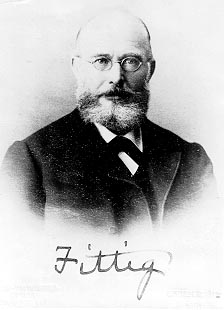- Wilhelm Rudolph Fittig
Infobox Scientist
name = PAGENAME
box_width =
image_size =150px
caption = PAGENAME
birth_date =December 6 ,1835
birth_place =Hamburg, Germany
death_date =November 19 ,1910
death_place =
residence = |citizenship =
nationality = German
ethnicity =
field =chemistry
work_institutions =
alma_mater =
doctoral_advisor =
doctoral_students =
known_for =Fittig reaction
author_abbrev_bot =|author_abbrev_zoo =
influences =
influenced =
prizes =
religion = |footnotes = |Wilhelm Rudolph Fittig (b.
December 6 ,1835 ,Hamburg, Germany –November 19 ,1910 ) was a Germanchemist . Fittig was responsible for discovery of thepinacol coupling reaction ,mesitylene ,diacetyl andbiphenyl . He studied the action ofsodium onketone s andhydrocarbon s. He discovered theFittig reaction orWurtz-Fittig reaction for the synthesis of alkylbenzenes, he proposed a diketone structure forbenzoquinone and isolatedphenanthrene fromcoal tar . He discovered andsynthesized the firstlactone s and investigated structures ofpiperine naphthalene andfluorene .Career
Fittig studied chemistry at
Göttingen , graduating asPh.D. with a dissertation onacetone in 1858, under the supervision ofHeinrich Limpricht andFriedrich Wöhler . He subsequently held several appointments at Göttingen, being "privat dozent" (1860), and extraordinary professor (1870). In 1870 he obtained the chair atTübingen , and in 1876 that atStrassburg , where the laboratories were erected from his designs. Fittig's researches are entirely inorganic chemistry , and cover an exceptionally wide field. Thealdehyde s andketone s provided material for his earlier work. He observed that aldehydes and ketones may suffer reduction in neutral,alkaline , and sometimesacid solution to secondary and tertiaryglycol s, substances which he named pinacones; and also that certain pinacones when distilled with dilutesulphuric acid gave compounds, which he named pinacolines. The unsaturated acids also received much attention, and he discovered the internalanhydride s ofoxyacid s, termedlactone s. In 1863 he introduced the reaction known by his name. In 1855 Adolph Wurtz had shown that when sodium acted uponalkyl iodide s, thealkyl residues combined to form more complexhydrocarbon s; Fittig developed this method by showing that a mixture of anaromatic andalkyl haloid , under similar treatment, yielded homologues ofbenzene . His investigations onPerkins reaction led him to an explanation of its mechanism which appeared to be more in accordance with the facts. The question, however, is one of much difficulty, and the exact course of the reaction appears to await solution. These researches incidentally solved the constitution ofcoumarin , the odoriferous principle ofwoodruff . Fittig and Erdmann's observation thatphenyl isocrotonic acid readily yieldedα-naphthol by loss of water was of much importance, since it afforded valuable evidence as to the constitution ofraphthalene . They also investigated certain hydrocarbons occurring in the high boiling point fraction of thecoal tar distillate and solved the constitution ofphenanthrene . We also owe much of our knowledge of the alkaloidpiperine to Fittig, who in collaboration withIra Remsen established its constitution in 1871. Fittig has published two widely used textbooks; be edited several editions of Wohler's "Grundriss der organischen Chemie" (11th ed., 1887) and wrote an "Unorganische Chemie" (1st ed., 1872; 3rd, 1882). His researches have been recognized by many scientific societies and institutions, the Royal Society awarding him the Davy medal in 1906.References
*1911
External links
* [http://www.scs.uiuc.edu/~mainzv/Web_Genealogy/Info/fittigwr.pdf Genealogy database entry, University of Illinois]
Wikimedia Foundation. 2010.
